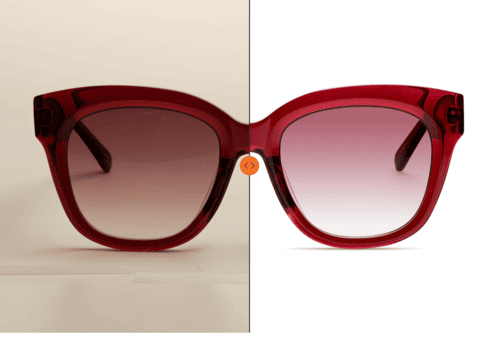Everything eCommerce Brands Need to Know About Setting Up an In-House Photography Studio
As eCommerce continues to dominate the retail landscape, the demand for high-quality product visuals has never been higher. An in-house photography studio for e-commerce businesses may seem like the solution for controlling costs and enhancing creative output. This guide explores everything you need to know about setting up and managing an in-house photography studio, from its appeal to the challenges and costs.

Why is An Idea of an In-House Photography Studio so Attractive?
The quality of your product photography has a direct impact on customer trust, conversion rates, and overall brand perception. Professionally shot images convey a sense of credibility and attention to detail, and customers are more likely to buy when they see clear, attractive images that highlight a product’s features. Accurate visuals reduce misunderstandings, lowering the risk of disappointed customers.
What Makes an In-House Studio A Good Solution for Brands
Many brands consider in-house studios because they promise:
- Speed and Agility: You can respond to new launches, trends, and campaigns in real time.
- Creative Control: Your team ensures consistency and adherence to your brand’s vision.
- Perceived Cost Savings: Producing visuals internally might feel like a more budget-friendly option compared to outsourcing.
For brands with frequent or high-volume content needs, these benefits are undeniably compelling.
Why Building an In-House Visual Content Studio Could Be More Complicated Than It Looks
While the benefits are compelling, many businesses underestimate the true scope of what it takes to build and run an in-house studio successfully. Let’s break down the challenges:
Space Requirements
The space must accommodate enough room for multiple setups, lighting rigs, and photographers to move freely, as well as a dedicated area for props, backdrops, and fragile equipment. It should also feature multiple layouts for diverse shoots, ranging from product photography to on-model scenes. Finding a space with these qualities can be difficult and expensive, especially in urban areas.
Equipment Costs
The list of required tools goes far beyond a camera, and it doesn’t stop there. Essential tools include powerful lighting setups like strobe or continuous lights for consistent illumination, paired with modifiers such as softboxes, umbrellas, or V-flats to control and shape the light. Backdrops, whether seamless paper for clean backgrounds or textured fabric for premium aesthetics, are held in place by durable stands, while diffusers and reflectors help balance the lighting for perfect exposure.
Lenses are another critical component, with macro lenses ideal for intricate details, prime lenses for sharp, distortion-free images, and versatile zoom lenses for dynamic framing. Supporting gear like shooting tables for flat-lay shots and turntables for 360-degree product photography enhances versatility, while tripods and light stands ensure stability during shoots.
Equipment also demands regular maintenance and periodic upgrades to stay competitive, ensuring your studio consistently meets evolving industry standards.
Talent Acquisition and Retention
A studio is only as good as the people running it. You’ll need skilled photographers, each with specialized expertise in product, lifestyle, or video shoots, as well as stylists and set designers to create visually compelling setups. Retouchers for post-production finesse that meets professional standards. Studio managers/producers/creative directors to coordinate schedules, oversee quality control, and handle logistics. Recruiting, training, and retaining this talent involves significant time and resources.
Operational Challenges
Managing an in-house studio involves coordinating shoot schedules, product preparation, and editing timelines. Ensuring consistency across hundreds or thousands of images. Balancing time and effort between high-priority campaigns and day-to-day tasks.
Additional Costs
- Utility bills spike with the energy demands of studio lighting and equipment.
- Software subscriptions for editing and workflow management add up.
- Hidden costs like insurance, equipment depreciation, and recruitment fees further strain budgets.
- Employees' taxes
An in-house studio can be a powerful asset for an eCommerce brand, offering speed, control, and creative freedom. But it’s not a decision to be made lightly. For many businesses, the perceived benefits are outweighed by the hidden complexities and ongoing demands. Understanding these nuances helps to get fully prepared for what it takes to build in-house studio production.
Planning Your Photography Studio Setup: Where to Begin
Building an in-house photography studio for your eCommerce brand starts with meticulous planning. The decisions you make here will determine how well your studio performs, how scalable it is, and whether it delivers the ROI (return on investment) you expect. Let’s break down the essential elements of planning, supported by facts, real-world considerations, and practical tips.
How to Choose the Perfect Space for Your Studio
To create a productive environment, you’ll need to evaluate your options based on several critical factors:
Lighting Conditions
Studies show that proper lighting can reduce post-production, as better lighting minimizes the need for extensive editing. Spaces with large windows and ample natural light are ideal for certain types of photography, especially lifestyle shoots. However, natural light can be inconsistent, varying with time of day and weather conditions.
Professional artificial lighting ensures consistent results but requires careful placement and additional costs. The room’s height and dimensions must allow for optimal light diffusion.
Room Capacity
The variety of setups required for professional product photography means your studio needs to be adaptable. Even small products like jewelry might demand intricate lighting setups and multiple angles, while larger items need spacious, clutter-free zones. Props, backdrops, and delicate equipment need organized storage to avoid damage and delays. Investing in the right space from the outset saves you from costly adjustments down the line.
A studio that feels adequate now might feel cramped as your business grows, requiring costly relocation or renovation. A typical product photography setup requires at least 2000–400 square feet of dedicated space, while on-model setups can demand 600 square feet or more.
Accessibility and Location
Equipment, products, and team members need to move in and out of the studio efficiently. The studio should ideally be close to your warehouse, marketing team, or product designers to facilitate collaboration. A well-placed studio near your fulfillment center can speed up the production-to-launch timeline by reducing transit times for products.
Creating Studio Layouts for Different Types of Shoots
In eCommerce photography, a “one-size-fits-all” studio rarely works. Each type of product or campaign has specific requirements that can’t always be met with a single setup.
For product photography, setups vary significantly depending on the size and nature of the product. Small items like jewelry require macro lenses, controlled lighting setups like lightboxes, and diffusers to minimize reflections. The workspace for such shoots should include a dedicated area for detailed work, free of clutter, with soft light sources positioned to enhance texture and sparkle.

Small and medium-sized products such as shoes and electronics often need modular shooting tables, versatile backdrops, and turntables for 360-degree imagery. These setups require additional space for proper lighting and camera movement. Larger products, such as furniture, necessitate floor-based setups with wide backdrops, high-powered lighting, and enough room for the photographer to maneuver around the object from multiple angles.
Lifestyle photography introduces more complexity. These shoots often require detailed scene construction to depict products in realistic settings. For example, photographing a sofa involves creating a living room setup with complementary furniture, decor, props and, obviously, models. Equipment needs include continuous lighting, adjustable softboxes, and reflectors. The studio must provide enough space to accommodate the scene and ensure optimal camera placement. A team is essential here, including a set designer for layout, a stylist for props and aesthetics, and a photographer experienced in capturing depth and balance. |
 |
For apparel photography, mannequin setups are efficient and versatile. Ghost mannequins are particularly effective, as they highlight the garment's structure and fit without distractions. These setups require adjustable mannequins, lighting systems that enhance fabric texture, and post-production retouching to remove the mannequin seamlessly. Apparel shoots can also involve flat-lay arrangements for detailed shots of stitching or embellishments, requiring proper overhead rigs and consistent lighting.

| On-model catalog photography showcases apparel fit, movement, and real-life appeal. It requires a spacious shooting area with a seamless white or neutral backdrop and consistent three-point or continuous lighting to highlight garments while minimizing shadows. Tethered shooting ensures real-time review of poses and garment presentation, a stylist adjusts clothing for a polished look, hair and makeup artists maintain the model’s appearance, and high-resolution cameras paired with prime or zoom lenses capture sharp, detailed images. | 
|
Interactive and video content setups demand specialized equipment and layouts. Video shoots often use stabilization gear for smooth panning and high-powered continuous lighting to ensure consistent exposure. For 360-degree product photography and video, motorized turntables and uniform backdrops are essential to produce smooth, distraction-free rotations. These setups require precise coordination between videographers, lighting technicians, and post-production editors to deliver polished results.
Efficiency and scalability are critical in studio design. Modular equipment, such as rolling backdrops and mobile lighting, allows quick transitions between setups. Storage solutions for props and tools help maintain organization and reduce downtime. Tethered shooting stations integrated into the workflow enable real-time image reviews, minimizing the need for reshoots and speeding up production.
Designing a photography studio for diverse eCommerce needs requires a strategic approach to layouts, equipment, and personnel. By tailoring each aspect of the studio to the specific requirements of product, lifestyle, apparel, and interactive shoots, brands can ensure high-quality, versatile content production.
Estimating the Real Costs of Studio Setup
Here’s a detailed look at where your money will go when setting up and running a professional photography studio:
Space Rental and Renovation Costs
Renting commercial space for a studio varies widely based on location and size, while renovations should include smooth pure white walls, floor and ceiling, so no colored hue would reflect on the images. This can significantly increase the initial investment.
Equipment Costs
A professional studio setup requires cameras, high-quality lenses, lighting systems like softboxes or strobes, a variety of props and backdrops, and a powerful computer with editing software. These expenses collectively account for a substantial portion of the budget, especially when factoring in regular upgrades and maintenance.
Staffing Costs
Running a studio requires skilled professionals, including photographers, retouchers, set designers, and stylists. Salaries or project fees for these roles add up quickly, along with additional expenses like payroll taxes, Medicare, and benefits for full-time staff.
Utilities and Operational Expenses
Studios consume a significant amount of electricity due to lighting and computer equipment. Operational costs also include insurance for equipment and liability coverage, as well as ongoing subscriptions for software tools.
Recruitment and Training Costs
Finding and hiring skilled talent for specialized shoots can be expensive, particularly for occasional campaigns like lifestyle or 360-degree photography. Continuous training is also necessary to keep the team updated on the latest tools and techniques, ensuring competitive output quality.
These costs collectively represent a substantial financial commitment, often exceeding initial expectations, particularly as the studio grows or scales to meet new demands.
Essential Equipment for a Professional Photography Studio Setup
Must-Have Tools for High-Quality Photography
The foundation of any photography studio lies in its core equipment like cameras, lenses, and lighting.
Cameras: A professional-grade DSLR or mirrorless camera is indispensable for capturing high-resolution, detailed images. These cameras offer manual controls, interchangeable lenses, and advanced sensor technology to adapt to various lighting conditions and shooting needs.
Lenses: Different types of lenses are required to cover a range of photography styles. Fixed focal lengths like 50mm or 85mm work for sharp, distortion-free shots. Versatile options like 24-70mm are good for flexibility in framing and angles. Macro lenses are irreplaceable for capturing fine details in small products like jewelry or watches.
Lighting Essentials: Consistent, professional lighting is critical for any studio. Common options include:
- Softboxes and Umbrellas for diffused lighting that eliminates harsh shadows.
- Strobes and Continuous Lights provide flexibility for both still photography and video content.
- Reflectors and Diffusers to control and soften light, ensuring balanced exposure.
- Lightboxes are particularly useful for small-to-medium products, offering even, controlled lighting for items like accessories, cosmetics, or electronics. Compact and versatile, it reduces the need for extensive post-production adjustments.
Table Computer with a Large Screen: A powerful computer with a calibrated large screen ensures accurate color reproduction during tethered shooting and post-production. Software like Capture One or Adobe Lightroom enhances the ability to edit in real time, reducing workflow bottlenecks.
Setting Up for Different Shoots with Backdrops and Props
A versatile studio must accommodate a range of eCommerce photography styles, which requires adaptable backdrops and a well-stocked collection of props. Interchangeable backdrops provide flexibility for different product categories. Seamless paper or fabric backdrops are common for catalog shots, offering clean, uniform backgrounds in white, gray, or brand-specific colors. Textured backdrops add depth and character, ideal for lifestyle shoots or premium products. Chroma Key (Green Screen) is used for more advanced editing and compositing.
Props are essential for creating context and enhancing product presentation. These can include furniture and decor for lifestyle scenes, neutral stands or blocks to elevate products for a better perspective, contextual props like utensils for kitchenware or flowers, velvet fabrics, and rocks for luxury goods.
A professional set designer in a studio ensures backdrops and props align with a shooting aesthetic. They craft visually appealing layouts that enhance product focus without distracting from key details. For example, a set designer might arrange complementary tones and textures for a handbag shoot, ensuring the product stands out while maintaining an on-brand atmosphere.
Related Read: What Is Set Design and Why Your eCommerce Photography Needs a Set Designer
How to Keep Things Up-to-Date to Match Professional Visual Content Standards
Professional equipment requires regular servicing to maintain precision and reliability. Camera sensors need periodic cleaning, lighting systems demand replacement bulbs, and turntables or rigs must be recalibrated for accuracy. Additionally, staying competitive often means upgrading to newer technology, which involves significant reinvestment.
Outfitting a professional studio is a continuous commitment. The initial investment runs into six figures, covering essential equipment, backdrops, and specialized tools. Over time, maintaining and upgrading these assets adds to operational costs. However, this investment is what ensures a studio's ability to produce consistent, high-quality visuals that meet the demands of eCommerce photography.
Challenges of Managing an In-House Photography Studio
Building an Efficient Workflow That Works
A well-functioning studio depends on a clear and efficient workflow, yet many businesses struggle to establish one. The complexity lies in synchronizing multiple processes, each with unique demands.
Scheduling Challenges
Juggling multiple campaigns or product categories can result in overlapping schedules. For example, a seasonal product launch may need immediate attention, disrupting regular shoots.
Products arriving late or with defects can derail carefully planned schedules, forcing reshoots or delays in delivery timelines just like waiting for approvals on shoot plans, styling, or final images often causing bottlenecks, especially in fast-paced e-commerce environments.
Product Preparation
Products need to be cleaned, polished, and sometimes assembled or styled before shooting. Apparel requires steaming and sometimes pinning, while smaller items like jewelry need to be spotless and dust-free. Handling dozens or hundreds of products for a single campaign requires streamlined logistics. Poor preparation can lead to high costs in post-production, wasting time and resources.
Post-Production Delays
Without enough skilled retouchers, an efficient process, or standardized editing guidelines, final images may not only be delivered off schedule but also appear inconsistent, creating an unprofessional look across the catalog.
An efficient workflow requires coordination between departments (e.g., marketing, design, and logistics), a clear roadmap for each campaign, and a team capable of managing high-pressure deadlines. Without these, even the best-equipped studios can fall behind schedule.
Space Capacity and Team Skills Gaps: Key Limitations
The physical and human resources of a studio directly affect its output. When these are inadequate, production slows down, and quality suffers.
Space Constraints
- Limited Room for Setups: A lack of space means constantly tearing down and rebuilding setups, which wastes time and risks inconsistencies.
- Storage Issues: Props, backdrops, and equipment need proper storage. Cluttered or cramped conditions lead to inefficiency and damage to expensive tools.
- Multi-Use Limitations: Studios often struggle to handle simultaneous shoots for different product categories, such as a lifestyle scene requiring furniture props and a tabletop shoot for jewelry.
Team Skills Gaps
- Specialization Challenges: Not all photographers or stylists excel in every type of shoot. A photographer skilled in flat-lay product images may lack the expertise needed for model or lifestyle shoots.
- Lack of Cross-Training: Without cross-training, team members may struggle to step into other roles when someone is unavailable. For instance, a retoucher unable to handle editing for both jewelry and apparel creates delays.
- Understaffing: Many businesses underestimate the size of the team required, leaving critical roles like set designers or lighting technicians unfilled.
Expanding space or hiring additional talent involves significant costs. Even when budgets allow, finding and retaining highly skilled professionals in specialized roles is challenging. If you want to know more about the professionals involved in the e-commerce visual content creation process, read our article here.
Maintaining Consistency and Quality Across Shoots and Retouching
Consistency is one of the most underestimated yet critical aspects of professional photography. For eCommerce, where hundreds or thousands of images are displayed together, any variation in quality stands out and diminishes brand credibility.
Consistency Across Shoots:
Without a consistent lighting setup, products shot on different days may look noticeably different, even within the same category. Changes in team members, props, or backdrops can lead to subtle but noticeable shifts in the visual style over time. Slight differences in camera height or angles create inconsistencies that distract customers and reduce the professional appeal of the catalog.
Retouching Challenges:
Without strict guidelines, retouchers may interpret edits differently, leading to uneven quality. Achieving true-to-life colors is especially challenging for apparel, cosmetics, or products with reflective surfaces. High-volume projects often stretch retouching resources, increasing the likelihood of rushed or subpar edits.
Want to learn more about the impact of retouching in eCommerce? Read our article on ‘The Impact of Product Photography Retouching on Online Sales’.
Brand Aesthetic Alignment:
When marketing, product, and creative teams all have input, aligning on a cohesive aesthetic becomes complex. As brands grow or rebrand, maintaining alignment with new guidelines can be difficult, especially when older team members or assets remain in circulation.
Maintaining consistency and quality requires detailed documentation, rigorous training, and continuous oversight, all of which demand time, money, and expertise. Without these safeguards, inconsistencies quickly creep in, affecting the overall brand image.
Scaling and Long-Term Costs of an In-House Studio
Expanding Your Studio to Match Business Growth
As your business grows, the volume and complexity of your content production will increase. Meeting these demands requires significant investment in infrastructure and resources. A growing product line or new photography styles (e.g., lifestyle or 360-degree) often necessitate additional setups. This could mean renting or renovating larger studio spaces to accommodate new equipment, multiple shooting zones, and storage for props and backdrops.
Advanced Technology Integration
To remain competitive and meet market demands, integrating advanced technology into your studio is often unavoidable. However, these upgrades come with both financial and operational challenges. Advanced equipment often demands specialized knowledge for operation and regular maintenance, which adds both time and cost to your studio’s ongoing operations.
A key challenge is to keep a balance between staying competitive with cutting-edge technology and managing the associated expenses is a constant tension.
Continuous Training to Keep Up with Industry Standards
The rapid evolution of photography technology and techniques means that ongoing education for your team is critical. Without it, your studio risks falling behind in quality and efficiency.
From mastering the latest editing software to understanding new lighting techniques, photographers and retouchers must stay updated. Hiring trainers, attending workshops, or enrolling employees in specialized courses involves direct costs. Moreover, team members undergoing training may need to pause their regular duties, leading to temporary productivity dips.
ROI Challenges: Is an In-House Studio Truly Cost-Effective?
The true cost-effectiveness of an in-house studio is often misunderstood. Many businesses focus on upfront savings but fail to account for the cumulative and recurring costs associated with maintaining and scaling operations. To understand the ROI of your studio, consider all associated costs:
- Photographer and retoucher salaries, including taxes and benefits.
- Equipment amortization over time and the cost of regular upgrades.
- Software subscriptions for editing and workflow tools.
- Space rental or mortgage payments.
- Utilities such as electricity for high-powered lighting and climate control.
- Management costs for scheduling, quality control, and logistics.
Example Calculation:
Divide the total monthly cost of the studio by the number of photos produced. Include multiple angles for each product to reflect realistic output needs. Then compare the per-photo cost with the rates offered by professional photography studios. Often, outsourcing proves to be more affordable, especially when accounting for consistency and quality guarantees.
Why Outsourcing to a Professional Studio Is a Smart Move
While an in-house photography studio offers control and convenience, the costs, complexity, and resource demands often make outsourcing to a professional studio the more strategic choice for many eCommerce businesses. Professional studios like LenFlash provide a streamlined, efficient solution to meet high-quality visual content needs without the overhead and challenges of managing a studio in-house.
Adaptable Photography Studio Setup Without the Hassle
Professional studios are designed for versatility, handling a variety of shoot types from product photography to lifestyle and video content without requiring businesses to invest in expensive infrastructure or tools. Studios already have the space, equipment, and setups needed for different types of photography, from intricate jewelry still life to outerwear on-model shootings.
Turnkey Solutions: Studios can adapt their setups to match your brand’s aesthetic, ensuring consistency across campaigns without requiring you to oversee the process.
You gain access to a fully operational studio without the time, money, or effort involved in setting one up yourself.
Solving Space Capacity and Team Challenges
Running an in-house studio often reveals space and staffing limitations. Professional studios eliminate these challenges by offering fully equipped spaces and expert teams.
Ample Space: Studios are built to accommodate everything from compact product shoots to expansive lifestyle setups. You won’t face space constraints or the inefficiencies of sharing zones for multiple types of shoots.
Experienced Team: Professional studios employ photographers, retouchers, stylists, and set designers who specialize in eCommerce photography. They understand the nuances of capturing products in a way that resonates with customers.
Streamlined Management: With trained staff handling everything from shoot coordination to post-production, you avoid the steep learning curve and ongoing effort of managing an in-house team.
Outsourcing ensures seamless execution, even for complex or high-volume projects, with a team of experts dedicated to delivering top-notch results.
Save Time, Save Money: focus on growing your business
Outsourcing allows eCommerce businesses to focus on core operations and growth rather than becoming bogged down by the logistics of content production.
Time Savings: By leaving photography to the experts, your team can dedicate time to marketing, product development, or customer engagement.
Cost Efficiency: Outsourcing eliminates the need for expensive equipment purchases, recruitment, training, or space rental. Instead, you pay for only the services you need, making it easier to scale up or down based on project demands.
No Talent Hunting: Finding and retaining skilled photographers, retouchers, or stylists can be time-consuming and costly. Studios handle talent recruitment, ensuring you work with experienced professionals.
Predictable Budgets: Outsourcing offers transparent pricing structures, making it easier to forecast costs without the unexpected expenses that often arise with in-house operations.
Businesses can reallocate resources to strategic priorities, knowing their visual content needs are in expert hands.
How LenFlash Delivers Scalable, High-Quality Results
Outsourcing to a professional LenFlash studio eliminates the costs, complexities, and resource demands of running an in-house photography operation. With access to versatile setups, expert teams, and efficient processes, outsourcing allows you to focus on growing your business while ensuring your brand is represented with professional, high-quality visuals. Order LenFlash professional Photography or Videography services today to streamline your content production and elevate your visual content with scalable, high-quality results.















